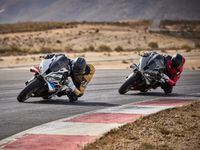After several riders had predicted that Sunday's Dutch Grand Prix at Assen would be a "group race—very close," it turned out to be anything but. The top four—Maverick Viñales, Marc Márquez, Fabio Quartararo, and Andrea Dovizioso—were all spaced just under five seconds apart.
At the start, the two Suzukis of Álex Rins and Joan Mir were first to turn 1, but Rins crashed out a lap later (“I think it was the wind”), leaving Mir, who would finish eighth, briefly at the front. After he ran wide, Viñales, Márquez, and Quartararo came through to form the lead group.
Ducati’s Danilo Petrucci, sixth, described the Suzukis, saying, “They are able to use the entire track [the big line]. If we try to enter the corner wide, we don’t reach the apex, so we have to tighten. It’s difficult to battle it out with them on tracks where there are no long straights and low-gear accelerations.”
This is the difference between a bike built to turn and a bike built to brake.
Each race this year spectators have yearned to see one of the “new boys” do the deed. This time, Quartararo cheerfully dominated practice and set pole for the third time this season and second consecutively. But in the race, his bike showed weave instability and, despite a recent corrective operation, his problem with arm pump returned. Under those circumstances, third, following a second two weeks earlier at Catalunya, was a great result.
Assen is a circuit that requires the very virtues that the Yamahas and Suzukis have. Its long, steady-state corners favor corner-speed bikes (especially since the track is bumpier this year; rough pavement slows the point-and-shoot bikes), and its frequent direction changes particularly favor the Yamahas. Indeed, although Quartararo ascribed his troubles to a combination of wind and tighter corner lines, which he called “stupid,” that fostered instability.
That may be. The thump that results when wind offsets a wheelieing bike, causing the front tire to come down off line is an upset quite similar to that used by test riders when evaluating stability: a hands-off thump to one bar to see how quickly the resulting oscillation dies away. I would therefore add that the Yamaha and Suzuki crew chiefs—knowing their bikes have an advantage in direction changing—may have pushed their steering geometry to the stability limit.
European Ducati teams competing at Daytona would suffer weave in first practice because the “lumber-wagon steering” of 1990s Ducati Superbikes required pushing to the stability limit, at least on European tracks. Daytona’s high-speed pushed that over the edge. Second practice would see them all stable again, having added some trail. Kawasaki, too, has been known for pushing to the threshold of instability to maximize steering quickness. If you’ve got it, flaunt it.
Viñales started second on the grid but a lap-one, turn-1 oscillation pushed him back to fourth.
Márquez is thinking of the championship, not of the next turn. Therefore, he knowingly chose Michelin’s soft rear slick option for its ability to keep him with the leaders for 15 of the 26 scheduled laps, after which he would improvise. The job was not to win but to maintain or increase his point lead over Dovizioso.
And the others? “I said yesterday Quartararo was 89 points behind us and Maverick is 100,” Márquez pointed out after the race, “so that is something I had in my mind.”
And where was the legendary top speed and lower-gear acceleration of the Ducatis? The nature of Assen requires specifically what the Ducati lacks. As Dovizioso said, “The problem has always been the same: There are long corners where you have to make the speed, and it’s not our best point.”
Making it all worse, he added, “[My tire dropped] in the middle of the race because I tried to stay with them at the beginning, but I was really on the limit; I used too much tire.” Dovizioso was on a hard-compound rear.
Petrucci, who has won a race this year, looked as though his setup was giving him more turning ability than that of Dovizioso, but, when asked about helping his teammate, he would only say, “They’ve just told me not to take any risks to overtake him. The goal is to win the world championship with Dovizioso.” Taking risks to overtake might end in taking his teammate down.
Viñales had confidence: “I was strong, even one-to-one on the brakes. I knew I could make the overtakes.”
Passes are usually made on corner entry, by braking later or otherwise going deeper. As we have often seen, when the rider making the pass has little margin, as in some of Márquez’s less-successful attempts, his deeper corner entry drives him wide on the exit, allowing the other man to repass under him. Viñales, knowing his bike was unlikely to run wide on this track, had enough margin not to be vulnerable to repasses on exit.
Even with that confidence, Viñales needed half the race to finally get free of Quartararo and Márquez. Then he displayed matchless pace to pull away and win by 4.8 seconds.
It’s very easy, seeing this race, to feel that, “Well, it’s finally happened. The old guys are finished, and the young guns are taking over.” Order will almost certainly be restored as soon as the series moves to tracks that again favor the speed, acceleration, and small-corner strengths of the Honda and Ducatis.
I say Honda, singular, for a reason. So far, Márquez is the only rider who can be consistently fast on the latest RC213V. Cal Crutchlow has his good and even his brilliant days with that “physical” bike, but he cannot so far put results together. And Jorge Lorenzo, even after proving to all that he could adapt to and win races on the Ducati, has now in the words of Márquez and Valentino Rossi entered a state in which, when he pushes on the Honda, he crashes. Lorenzo’s Assen crash in Friday practice is his third in recent weeks and damaged two vertebrae enough to spend the next two GPs in a brace. Like Johann Zarco, now with KTM, Lorenzo needs his Yamaha.
This isn’t a new problem. In the 1980s, I worked with a rider who had worked his way to actually making money on a springy, difficult Yamaha TZ750. But when, with that money, he bought a Honda RS500 triple, he became a novice all over again, saying, “I hope it’s not going to take me four years of crashing to learn to ride this thing.”
Riders desperately need to be fast now because the moments that make or break a career are ticking by.
Rossi, many times successful at Assen, just couldn’t feel right through practice, started far back, but found 0.6 second in Sunday morning warm-up. Then he lost the front on lap five and took down Takaaki Nakagami. Yet, at 40 years of age, Rossi has more championship points than any other Yamaha rider.
Why the larger-than-usual gaps among the top four riders, reminding us of the two-stroke years? Viñales settled once he got free of Márquez, who, with immediate prospect of leaving Assen with a 44-point championship lead, had no reason to cross swords with anyone near him. Quartararo, fast gaining the experience he will need to win, was doing well to stay where he was with an unstable bike and a visibly painful arm. And Dovizioso was suffering “Ducati disease,” loss of tire properties in the second half, brought on by higher temperature.
On to Sachsenring and a fresh matrix of problems.











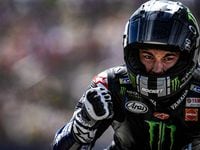
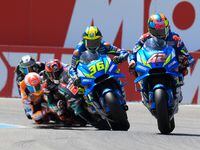
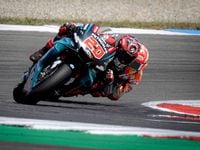
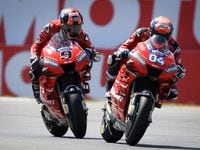
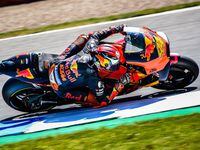
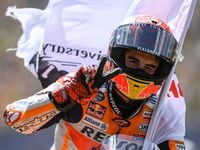
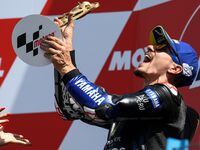
/cloudfront-us-east-1.images.arcpublishing.com/octane/JJ3MC6GNDFF5ZNYD3KD3E4EY7Y.jpg)
/cloudfront-us-east-1.images.arcpublishing.com/octane/XH2ETEU4NVGDFNQO2XT2QQS5LU.jpg)
/cloudfront-us-east-1.images.arcpublishing.com/octane/UFG652C27BDBFPK42TDAJ5CMX4.jpg)
/cloudfront-us-east-1.images.arcpublishing.com/octane/AUE3NFVRRZDSBIDVUGIYIDQNUI.jpg)
/cloudfront-us-east-1.images.arcpublishing.com/octane/LYR62CH2WNBMHJJVXVATZHOUE4.jpg)
/cloudfront-us-east-1.images.arcpublishing.com/octane/RBCTRGBQYBDK7A6XPG3HKPS7ZQ.jpg)
/cloudfront-us-east-1.images.arcpublishing.com/octane/MQXQRYMZVBCWJIRYP3HEN3SHVE.jpg)
/cloudfront-us-east-1.images.arcpublishing.com/octane/TSPODNNEWRDSVJGUCNQTDG4ADI.jpg)
/cloudfront-us-east-1.images.arcpublishing.com/octane/X5TB7BDV4BA2RPSY54ZGK27RP4.jpg)
/cloudfront-us-east-1.images.arcpublishing.com/octane/REUHOJXRDBGZ5IHBYZCCBCISPA.jpg)
/cloudfront-us-east-1.images.arcpublishing.com/octane/52LGJTCKBFEHDF7S7H4CVUIMGM.jpg)
/cloudfront-us-east-1.images.arcpublishing.com/octane/YMWAIPIPSJAOXOU3QMJMGH37OM.jpg)


/cloudfront-us-east-1.images.arcpublishing.com/octane/EJ6KZRGAYBCVXNL2PJXL37UVWQ.jpg)
/cloudfront-us-east-1.images.arcpublishing.com/octane/AAN4TI76M5H5JMUVEIGASWXBDU.jpg)
/cloudfront-us-east-1.images.arcpublishing.com/octane/P3RXD2UCPFF37CMB7CHPVKXORY.jpg)
/cloudfront-us-east-1.images.arcpublishing.com/octane/VZEG2EJI2RDFZNHLRZMU56MD3Q.jpg)
/cloudfront-us-east-1.images.arcpublishing.com/octane/GVJQO5FFOFBWNGODOBRB4FBAW4.jpg)
/cloudfront-us-east-1.images.arcpublishing.com/octane/BIVAK2SFIBDJJM25E7I5VU2FJE.jpg)
/cloudfront-us-east-1.images.arcpublishing.com/octane/CH5VX52UG5CFHOVH5A6UYEFWWA.jpg)
/cloudfront-us-east-1.images.arcpublishing.com/octane/ZVGJNGZRU5C33N7KN23BBFKSC4.jpg)

